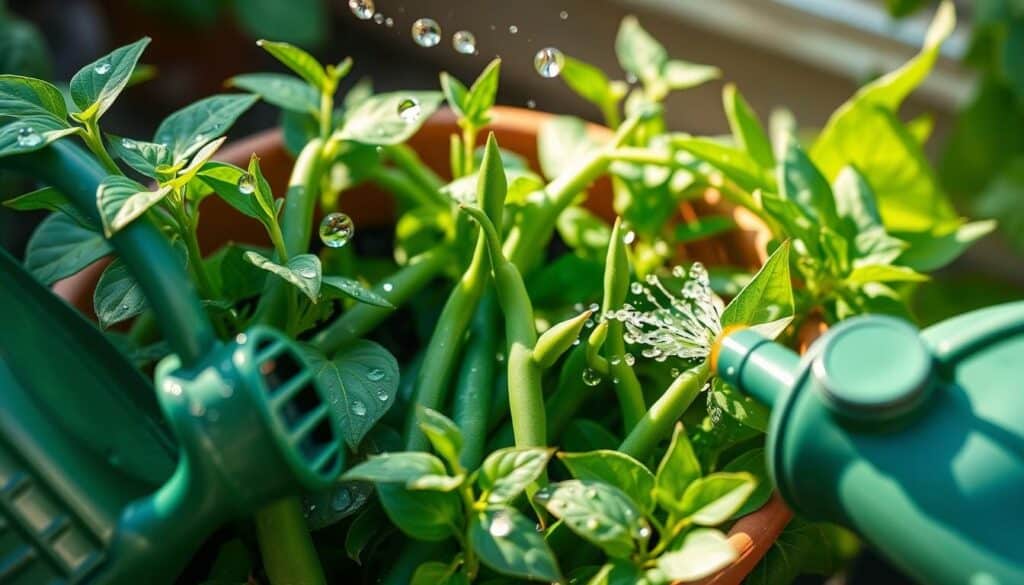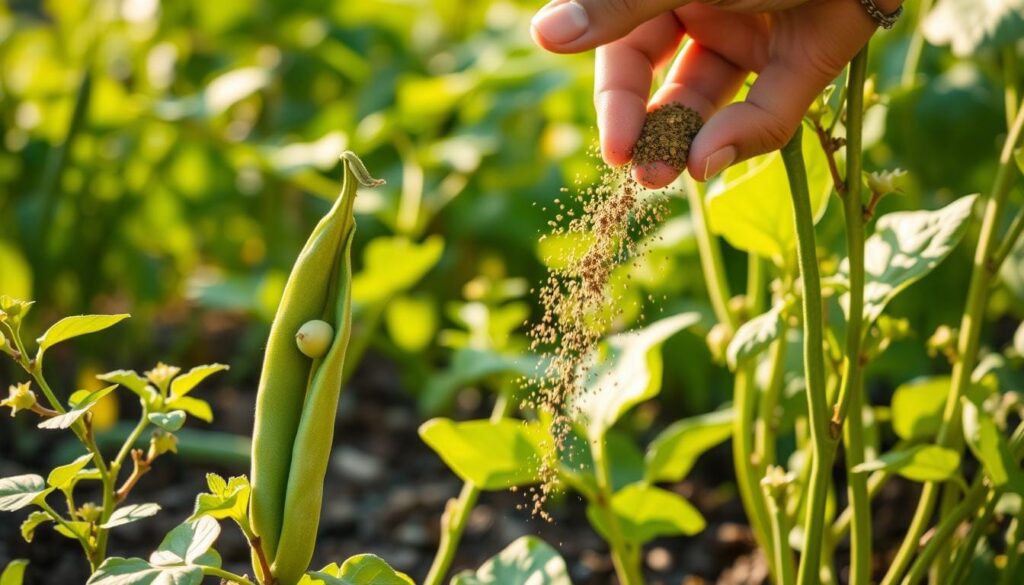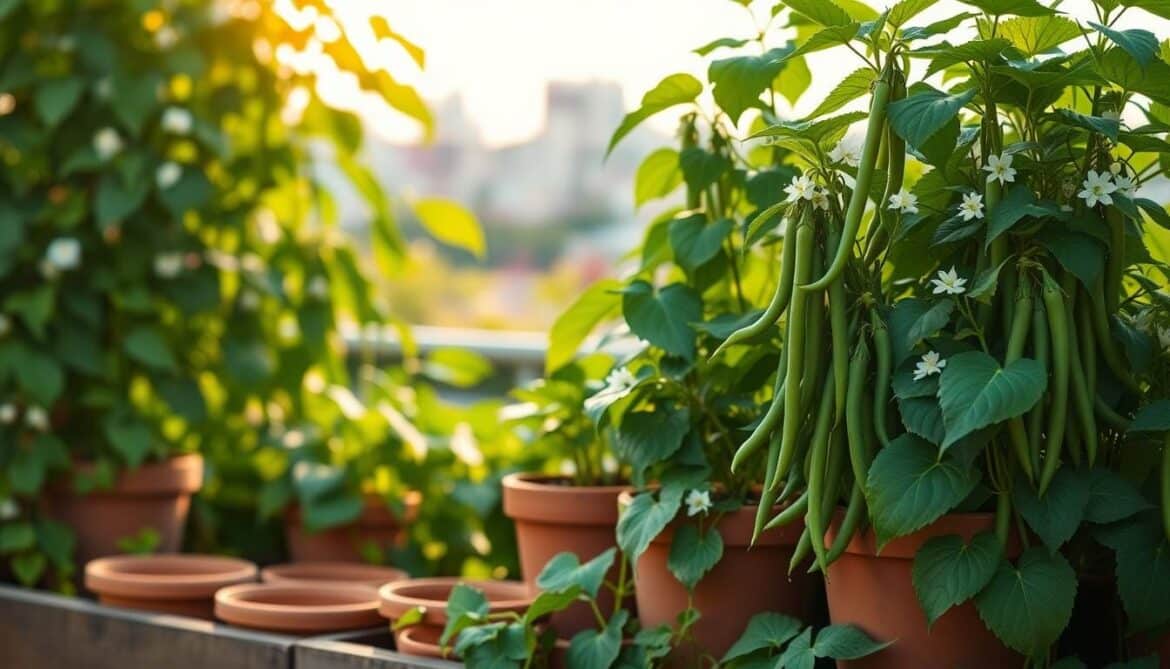Growing green beans in a container has turned my small balcony into a lively garden. It’s amazing how container gardening can make the most of tiny spaces. It’s perfect for those who love plants and want to grow their own food at home.
Container gardening lets you grow green beans even with little outdoor space. Whether you have a small balcony or a tiny patio, you can make it a garden. It’s all about learning how to grow green beans in a container.
In this guide, we’ll show you how to garden with green beans in containers. You’ll see how easy it is to grow tasty, fresh beans. You don’t need a big garden or lots of experience to do it.
Key Takeaways
- Container gardening enables green bean cultivation in restricted spaces
- Bush and pole bean varieties suit different container gardening needs
- Minimal equipment required for successful green bean production
- Potential for multiple harvests within a single growing season
- Accessible gardening method for urban and suburban environments
Benefits of Growing Green Beans in Containers
Vegetable gardening fans are finding great benefits in growing green beans in containers. This method turns small areas into gardens. It lets city folks and those with little land grow their own food.
Space Efficiency for Urban Gardens
Container gardening is a smart way to save space for green beans. Even a tiny balcony or patio can grow a lot. An 18-inch container is perfect for pole beans, and a 15-inch one is great for bush beans.
- Maximize limited outdoor spaces
- Create vertical gardening opportunities
- Transform urban areas into productive gardens
Accessibility for All Gardeners
Container gardening makes growing green beans easy for everyone. Raised containers mean no bending or kneeling. This makes gardening fun and accessible for all.
Extended Growing Season
Containers let you grow green beans in any weather. You can move plants to avoid frost or heat. This way, you can grow beans longer and enjoy them fresh.
- Protect plants from harsh weather
- Relocate containers for optimal sunlight
- Maintain ideal growing conditions
Container gardening opens up new ways to grow tasty, healthy green beans anywhere.
Choosing the Right Green Bean Variety
Choosing the right green bean variety is key to a successful container garden. Knowing the unique traits of each variety ensures a good harvest.
Bush Beans vs. Pole Beans: Understanding the Differences
When planting green beans, you have two main choices:
- Bush Beans: These plants are small, growing 1-2 feet tall.
- Pole Beans: These climbing beans need trellises or supports.
| Characteristic | Bush Beans | Pole Beans |
|---|---|---|
| Maturity Time | Faster (50-55 days) | Longer (60-70 days) |
| Harvest Period | Short, concentrated | Extended throughout season |
| Space Requirements | Compact | Vertical growing space needed |
Local Climate Considerations
Think about your local climate when picking green bean varieties. Some do better in certain temperatures:
- Heat-tolerant varieties like Blue Lake are great for warm areas.
- Scarlet Runner beans are best for cooler climates.
- For short growing seasons, choose quick-growing bush beans.
Seed Selection Tips
Here are some top green bean varieties:
- Kentucky Wonder: Produces a lot and tastes great.
- Contender: Perfect for canning and planting again.
- Rattlesnake: Performs well in the heat.
Start by picking the right green bean variety for your garden. Try different types to find the best for your container garden.
Selecting Suitable Containers
Container gardening is a fun way to grow green beans, even with little space. Picking the right container is key for successful green bean growing tips. The right container can greatly improve your vegetable harvest.
Size Matters for Green Bean Containers
Choosing the right size container for green beans is important. We recommend different sizes for different bean types:
- Bush beans need a container at least 15 inches in diameter
- Pole beans require a larger container, around 18 inches in diameter
- Containers should offer about 288 cubic inches of growing space
Ensuring Proper Drainage
Drainage is vital in container gardening. Traditional soil can be too dense, causing root rot and fungal problems. Here’s what we suggest:
- Use 2-4 drainage holes in plastic containers
- Choose containers with pre-existing drainage holes
- Avoid waterlogged soil at all costs
Exploring Container Materials
The material of the container affects plant health and growth. Our tips include these options:
- Plastic: It’s lightweight and affordable
- Terracotta: It’s great for breathability
- Fabric grow bags: They offer superior root aeration
By choosing the right container, we can create a perfect environment for green beans in our container gardening journey.
Preparing the Soil for Our Green Beans
Starting a vegetable garden means knowing the right soil for your green beans. Preparing the soil is key to a successful container garden. It helps your plants grow well and give you lots of harvests.
Choosing the right soil mix is vital for growing green beans. These plants are adaptable but need specific soil conditions. Gardeners should understand these needs.
Soil Type Recommendations
For the best green bean growth, use a high-quality potting mix. The best soil is slightly acidic to neutral pH (6.0-7.0). It should also be loamy, with good nutrients and drain well.
- Slightly acidic to neutral pH (6.0-7.0)
- Loamy texture with good nutrient content
- Excellent drainage capabilities
Testing Soil pH Levels
Knowing your soil’s pH is key for growing green beans. Beans do best in slightly acidic soil that helps them absorb nutrients. Use a home pH testing kit to check your soil’s acidity.
| pH Range | Soil Condition | Bean Growth Impact |
|---|---|---|
| Below 6.0 | Too Acidic | Reduced Nutrient Uptake |
| 6.0-7.0 | Ideal Range | Optimal Growth |
| Above 7.0 | Too Alkaline | Nutrient Lockout |
Enriching Soil with Compost
To make your soil rich for green beans, add compost or aged manure. This makes the soil better for plants, improves drainage, and adds nutrients for growth.
- Mix 2-3 inches of compost into your potting soil
- Use organic, fully decomposed compost
- Avoid fresh manure, which can burn plant roots
By following these tips, you’ll make a great soil environment for your green beans. Your container garden will thrive and give you lots of healthy plants.
Planting Green Beans in Containers
Planting green beans in containers is a fun way to grow fresh veggies, even with little garden space. Our guide will show you how to grow green beans in containers successfully.
When growing green beans in containers, timing and technique are key. Green beans love warm weather, best when the soil is between 70°F and 85°F. Planting green beans needs careful thought about a few important things.
Optimal Planting Depth and Spacing
For great container gardening, follow these tips:
- Plant seeds 1 inch deep in the soil
- Space bush bean seeds 3 inches apart
- Space pole bean seeds 9-12 inches apart
- Use containers at least 8-12 inches deep
Container Selection for Green Beans
Choose containers that help green beans grow well:
- Bush beans: 2-gallon containers (3 plants)
- Pole beans: 5-gallon containers (3 plants)
- Fabric grow bags work great for beans
Timing Your Planting
Planting success depends on the weather and temperature. Wait until nighttime temperatures stay above 50°F. In most places, this is when you plant tomatoes too.
Pro tip: Plant green beans every 2-3 weeks for a steady harvest all season.
Watering Green Beans in Containers
Caring for green beans means paying close attention to how you water them. Growing them in containers can be tricky because it’s hard to keep the soil just right. Water is key for your green beans to grow well.

To grow green beans, you need to know how much water they need. When they’re young, they need water often to grow. But as they get bigger, they need less water.
Frequency of Watering
Here are some tips for watering your green beans:
- Water deeply when the top 2-3 inches of soil feel dry
- Give them about 1 inch of water each week
- Water more often when it’s very hot
- Water less when it’s cooler
Recognizing Water Stress
Knowing when your green beans need water is important:
- Underwatering symptoms:
- Drooping leaves
- Yellowing foliage
- Stunted growth
- Overwatering indicators:
- Soggy soil
- Root rot
- Mold growth
Efficient Watering Techniques
Here are some ways to water your green beans well:
- Use drip irrigation systems
- Water at the base of plants
- Mulch to keep moisture in
- Choose self-watering containers
By using these watering tips, you can grow healthy green beans in your containers.
Supporting Pole Beans in Container Gardens
Growing green beans in a container needs careful planning for vertical support. Knowing about support structures is key for growing green beans successfully. Pole beans, being vining plants, need strong structures to climb and grow well.
Types of Support Structures
Our green bean growing tips suggest several support options for container gardening:
- Trellises: Vertical frames perfect for compact spaces
- Teepees: Triangular structures allowing beans to climb naturally
- Bean towers: Tall, narrow supports ideal for container gardens
Timing for Support Installation
For successful pole bean cultivation, set up support structures before or during seed planting. This avoids disturbing the roots and helps young plants grow right.
Training Beans to Grow Upward
Start by gently guiding young bean tendrils toward the support. As they grow, they’ll naturally wrap and climb. Make sure supports are 6-7 feet tall and strong enough for mature vines.
“A well-supported bean plant is a productive bean plant” – Container Gardening Wisdom
By using these support strategies, we can make the most of our container garden’s vertical space. This ensures a rich harvest of green beans.
Fertilizing Our Green Beans
Caring for green beans in our vegetable garden means knowing their special needs. Green beans are unique because they can make their own fertilizer. This is thanks to their ability to fix nitrogen.

Most green bean plants don’t need much extra fertilizer if they’re in good soil. Their ability to make nitrogen makes them easy to care for. This is compared to other garden vegetables.
Selecting the Right Fertilizer
When we do need to fertilize, here are some good choices:
- Organic compost
- Light 5-10-10 balanced fertilizer
- Rhizobia inoculant for seed treatment
- Liquid fish emulsion
Application Timing and Frequency
For green beans in containers, fertilizing should be careful and rare. Here’s what we do:
- Give a light fertilizer halfway through the season
- Use liquid fertilizers every 2-4 weeks
- Stop fertilizing when beans start to grow
Organic vs. Synthetic Fertilizer Choices
In our gardening, organic fertilizers work best for green beans. Organic options feed the soil ecosystem and give slow, steady nutrients. This helps plants stay healthy.
Green beans do best in soil with a pH of 6.0 to 7.5. A soil test can show if more nutrients are needed for growth.
Pest and Disease Management
Caring for green beans means watching out for pests and diseases. Container gardens have special needs. We must act fast to keep our plants healthy.
Green bean plants face many threats from pests and diseases. Knowing these dangers helps us protect our crops. This way, we can enjoy a full harvest.
Common Pests Threatening Green Beans
- Aphids: Tiny insects that cluster on leaf undersides
- Spider mites: Microscopic pests causing leaf discoloration
- Bean beetles: Small insects that consume leaf tissue
Organic Pest Control Methods
We suggest using eco-friendly ways to fight pests:
- Neem oil spray for natural insect repellent
- Diatomaceous earth as a physical pest barrier
- Insecticidal soap for soft-bodied insects
- Introducing beneficial insects like ladybugs
Disease Prevention and Management
To prevent diseases in green beans, follow these steps:
Don’t work in wet conditions to stop fungal diseases. Regular checks help find problems early.
Our main strategies are good air flow, using resistant varieties, and rotating crops. This keeps the soil healthy.
Harvesting Our Green Beans
Growing green beans in containers is very rewarding, from the moment you harvest them. Harvesting green beans needs careful steps to get the best results and keep your plants healthy.
Knowing when to pick your green beans is key. Green bean tips say to pick them when they’re medium-sized and firm. They should be between 4 to 6 inches long.
Signs of Bean Readiness
- Pods are smooth and firm to the touch
- Beans have reached 4-6 inches in length
- No visible bulging from seeds inside the pod
- Color is bright green and vibrant
Optimal Harvesting Techniques
When you harvest green beans, be gentle to avoid harming the plant. Always use two hands: one to hold the plant stem and the other to carefully pick the bean. This way, you won’t damage your container plants.
| Bean Type | Harvest Time | Picking Frequency |
|---|---|---|
| Bush Beans | 50-55 days after planting | Every 2-3 days |
| Pole Beans | 55-65 days after planting | Every 2-3 days |
Storing Fresh Green Beans
After you pick them, store your green beans in the fridge. Put them in a bag with holes to keep them moist but let air in. They usually last 3-5 days when stored right.
- Rinse beans just before using
- Remove any damaged or discolored pods
- Keep beans dry to prevent mold
- Store in the crisper drawer
Harvesting regularly helps your beans keep growing. This way, your container garden will be full of beans all season long.
Troubleshooting Common Issues in Container Gardening
In our vegetable gardening journey, green bean growing tips can help us navigate unexpected challenges. Container gardens need special care to keep plants healthy. Even with careful planning, gardeners might face problems that seem frustrating but are often easily fixed with the right knowledge.
Yellow leaves can signal nutrient deficiencies in our green bean containers. This usually means we need to balance our fertilization. We suggest using a 10-10-10 NPK fertilizer every 2-4 weeks. This ensures our plants get enough nitrogen, phosphorous, and potassium.
Slow growth might be due to not enough sunlight. Most vegetables need at least 6 hours of direct sun daily.
Drainage problems can quickly ruin our container gardening efforts. Make sure planter boxes are at least 10 inches deep for beans and have enough drainage holes. Waterlogged soil leads to fungal growth and root rot. By keeping an eye on moisture and using well-draining potting mix, we can avoid most problems and keep our green bean plants strong and productive.
Prevention is key in successful vegetable gardening. Regular checks, proper watering, and balanced nutrition help us overcome growing challenges. This way, we can enjoy a bountiful harvest of delicious green beans.

